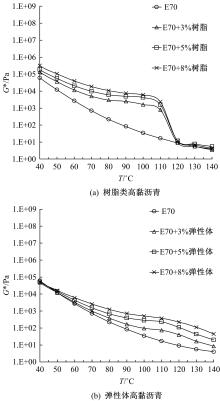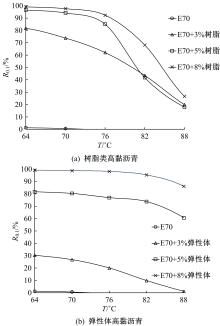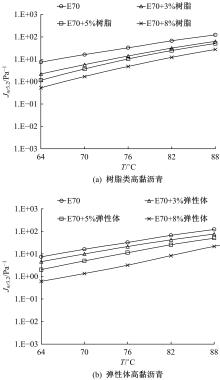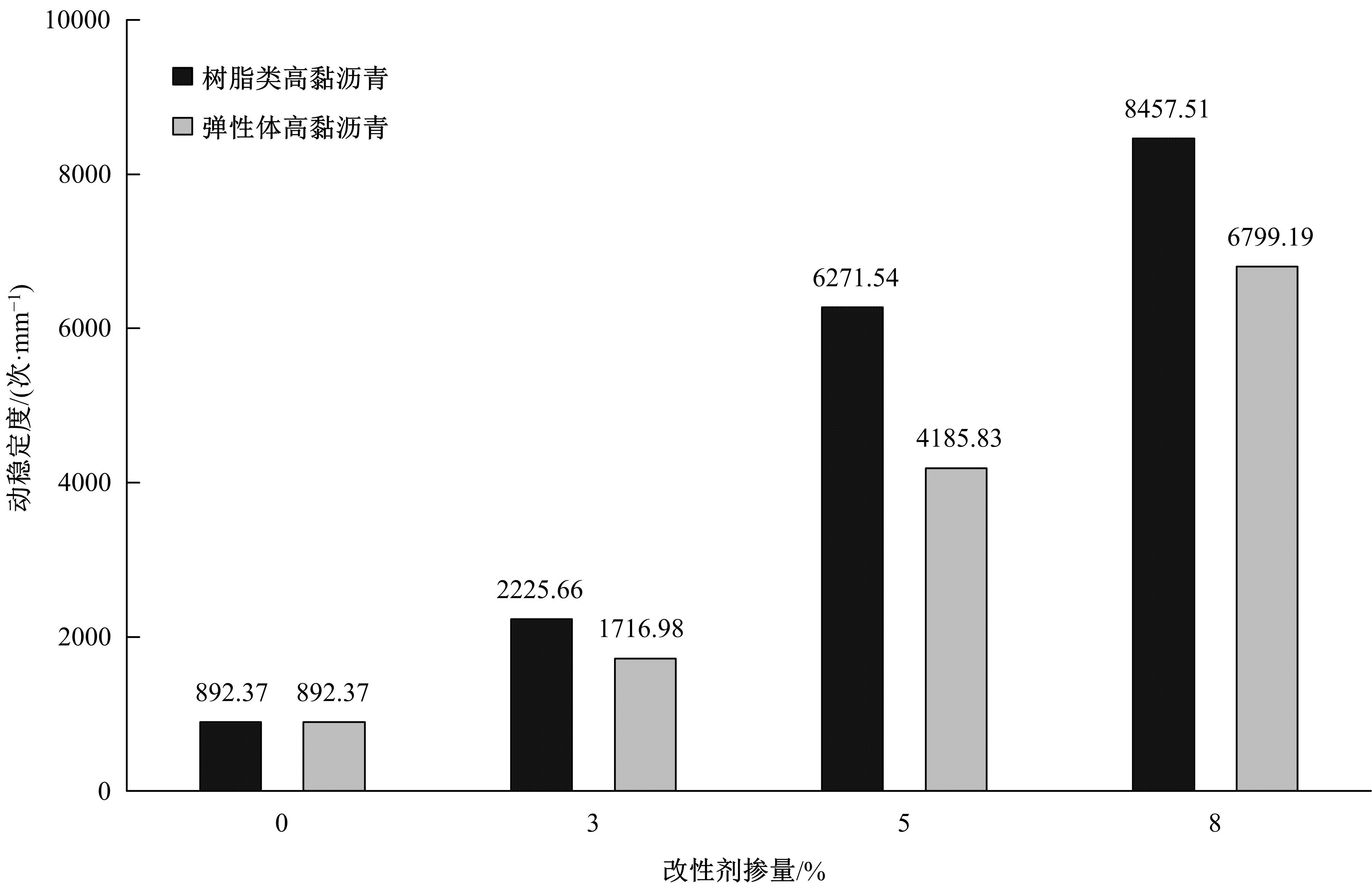Journal of Jilin University(Engineering and Technology Edition) ›› 2023, Vol. 53 ›› Issue (7): 2078-2088.doi: 10.13229/j.cnki.jdxbgxb.20210991
High-temperature performance evaluation of resin and elastomer high viscosity asphalt based on grey correlation analysis
Zheng-feng ZHOU1,2( ),Xiao-tao YU1,2,Ya-le TAO1,2,Mao ZHENG3,Chuan-qi YAN1,2(
),Xiao-tao YU1,2,Ya-le TAO1,2,Mao ZHENG3,Chuan-qi YAN1,2( )
)
- 1.School of Civil Engineering,Southwest Jiaotong University,Chengdu 610031,China
2.Highway Engineering Key Laboratory of Sichuan Province,Southwest Jiaotong University,Chengdu 610031,China
3.Sichuan Transportation Construction Group Co. ,Ltd. ,Chengdu 610047,China
CLC Number:
- U414.1
| 1 | 祝斯月,陈拴发,秦先涛,等. 透水性沥青路面高粘改性沥青动态力学性能[J]. 武汉理工大学学报, 2012, 34(12): 52-56. |
| Zhu Si-yue, Chen Shuan-fa, Qin Xian-tao, et al. Dynamic mechanical properties of high viscosity modified asphalt for permeable asphalt pavements[J]. Journal of Wuhan University of Technology, 2012, 34(12): 52-56. | |
| 2 | özen H, Aksoy A, Tayfur S, et al. Laboratory performance comparison of the elastomer-modified asphalt mixtures[J]. Building and Environment, 2008, 43(7): 1270-1277. |
| 3 | Yan K, Tian S, Chen J, et al. High temperature rheological properties of APAO and EVA compound modified asphalt[J]. Construction & Building Materials, 2020, 233: No.117246. |
| 4 | Qin X, Zhu S, He X, et al. High temperature properties of high viscosity asphalt based on rheological methods[J]. Construction & Building Materials,2018, 186: 476-483. |
| 5 | Liao M, Chen J. Zero shear viscosity of bitumen-filler mastics[J]. Journal of Materials in Civil Engineering, 2011, 23(12): 1672-1680. |
| 6 | Morea F, Agnusdei J O, Zerbino R. Comparison of methods for measuring zero shear viscosity in asphalts[J]. Materials and Structures, 2010, 43(4): 499-507. |
| 7 | Morea F, Morea F, Agnusdei J O, et al. The use of asphalt low shear viscosity to predict permanent deformation performance of asphalt concrete[J]. Materials and Structures, 2011, 44(7): 1241-1248. |
| 8 | Morea F, Morea F, Zerbino R, et al. Improvements on asphalt mixtures rutting performance characterization by the use of low shear viscosity[J]. Materials and Structures, 2013, 46(1): 267-276. |
| 9 | D'Angelo J. The Relationship of the MSCR test to rutting[J]. Road Materials and Pavement Design, 2009, 10: 61-80. |
| 10 | Huang W, Tang N. Characterizing SBS modified asphalt with sulfur using multiple stress creep recovery test[J]. Construction & Building Materials, 2015, 93: 514-521. |
| 11 | Yan C, Huang W, Lin P, et al. Chemical and rheological evaluation of aging properties of high content SBS polymer modified asphalt[J]. Fuel (Guildford), 2019, 252: 417-426. |
| 12 | 银花,李凯. 沥青零剪切黏度与高温流变参数灰色关联分析[J]. 建筑材料学报, 2020, 23(1): 108-113. |
| Yin Hua, Li Kai. Gray correlation analysis of asphalt zero shear viscosity and high temperature rheological parameters[J]. Journal of Construction Materials, 2020, 23(1): 108-113. | |
| 13 | 韩海峰,何桂平,吕伟民. 沥青混合料永久变形特性对结合料广义动态剪切模量的响应[J]. 公路交通科技,2004, 21(3): 1-5. |
| Han Hai-feng, He Gui-ping, Lv Wei-min. Response of permanent deformation properties of asphalt mixtures to the generalized dynamic shear modulus of the binding material[J]. Road Traffic Science and Technology, 2004, 21(3): 1-5. | |
| 14 | 金磊,钱振东,郑彧. 基于DMA方法的浇注式沥青胶浆高温性能及评价指标[J]. 东南大学学报:自然科学版, 2014, 44(5): 1062-1067. |
| Jin Lei, Qian Zhen-dong, Zheng Yu. High temperature performance and evaluation index of cast asphalt mastic based on DMA method[J]. Journal of Southeast University(Natural Science Edition), 2014, 44(5): 1062-1067. | |
| 15 | Mohammad R, Ellie H, Asce M, et al. Rutting characteristics of styrene-ethylene/propylene-styrene polymer modifier asphalt[J]. American Society Civil Engineers, 2015, 27(4): 1-5. |
| 16 | Shi J, Fan W, Qian C, et al. Effect of high viscosity modifier on rheological properties and microstructure of high viscosity asphalt[J]. AIP Conference Proceedings, 2020, 2258(1):1-10. |
| 17 | Chen J, Liao M, Shiah M. Asphalt modified by styrene-butadiene-styrene triblock copolymer: morphology and model[J]. Journal of Materials in Civil Engineering, 2002, 14(3): 224-229. |
| 18 | He Xiao-ming, Eldouma I B. Experimental study to determine the most preferred additive for improving asphalt performance using polypropylene, crumb rubber, and tafpack super in medium and high-temperature range[J]. Applied Sciences, 2019, 9(8): 1567. |
| 19 | Yan C, Huang W, Ma J, et al. Characterizing the SBS polymer degradation within high content polymer modified asphalt using ATR-FTIR[J]. Construction & Building Materials, 2020, 233:No.117708. |
| 20 | Iwanski M, Mazurek G. Rheological characteristics of synthetic wax-modified asphalt binders[J]. Polimery, 2012, 57(9): 661-664. |
| 21 | Zhang X R, L Z Q. Study on one new grey simi-larity correlation degree model and its applications[J]. Journal of Chemical and Pharmaceutical Research, 2014, 6(6): 1406-1411. |
| 22 | Wang Z. Correlation analysis of sequences with interval grey numbers based on the kernel and greyness degree[J]. Kybernetes, 2013, 42(2): 309-317. |
| 23 | Fen Y, Kong Z, J X. Evaluation of shear performance of flexible waterproof-adhesive layer in concrete bridge pavement based on grey correlation analysis[J]. Road Materials and Pavement Design, 2009, 10(Sup.1): 349-360. |
| [1] | Liu YANG,Chuang-ye WANG,Meng-yan WANG,Yang CHENG. Traffic flow characteristics of six⁃lane freeways with a dedicated lane for automatic cars [J]. Journal of Jilin University(Engineering and Technology Edition), 2023, 53(7): 2043-2052. |
| [2] | Tao MA,Yuan MA,Xiao-ming HUANG. Optimal combination of key parameters of intelligent compaction based on multiple nonlinear regression [J]. Journal of Jilin University(Engineering and Technology Edition), 2023, 53(7): 2067-2077. |
| [3] | Hai-bin WEI,Shuan-ye HAN,Hai-peng BI,Qiong-hui LIU,Zi-peng MA. Intelligent sensing road active ice and snow removal system and experimental technology [J]. Journal of Jilin University(Engineering and Technology Edition), 2023, 53(5): 1411-1417. |
| [4] | Sui-ning ZHENG,Rui HE,Tian-yu LU,Zi-yi XU,Hua-xin CHEN. Preparation and evaluation of RET/rubber composite modified asphalt and asphalt mixture [J]. Journal of Jilin University(Engineering and Technology Edition), 2023, 53(5): 1381-1389. |
| [5] | Bo-wen GUAN,Wen-jin DI,Fa-ping WANG,Jia-yu WU,Shuo-wen ZHANG,Zhi-xun JIA. Damage of concrete subjected to sulfate corrosion under dry⁃wet cycles and alternating loads [J]. Journal of Jilin University(Engineering and Technology Edition), 2023, 53(4): 1112-1121. |
| [6] | Fan YANG,Chen-chen LI,Sheng LI,Hai-lun LIU. Numerical simulation of continuously reinforced concrete pavement with double⁃layer reinforcement under effect of temperature shrinkage [J]. Journal of Jilin University(Engineering and Technology Edition), 2023, 53(4): 1122-1132. |
| [7] | Hai-bin WEI,Zi-peng MA,Hai-peng BI,Han-tao LIU,Shuan-ye HAN. Conductive rubber composite pavement paving technology based on mechanical response analysis method [J]. Journal of Jilin University(Engineering and Technology Edition), 2023, 53(2): 531-537. |
| [8] | Zhuang-zhuang LIU,You-wei ZHANG,Peng-yu JI,Abshir Ismail Yusuf,Lin LI,Ya-zhen HAO. Study on heat transfer characteristics of electric heating snow melting asphalt pavement [J]. Journal of Jilin University(Engineering and Technology Edition), 2023, 53(2): 523-530. |
| [9] | Qing-lin GUO,Qiang LIU,Chun-li WU,Li-li LI,Yi-ming LI,Fu-chun LIU. Local temperature field and healing level of crack in conductive asphalt and mixture [J]. Journal of Jilin University(Engineering and Technology Edition), 2022, 52(6): 1386-1393. |
| [10] | Cheng-lin SHI,Yong WANG,Chun-li WU,Wen-zhu SONG. Modification of calculation method for active earth pressure on embankment retaining wall [J]. Journal of Jilin University(Engineering and Technology Edition), 2022, 52(6): 1394-1403. |
| [11] | Yu-quan YAO,Jian-gang YANG,Jie GAO,Liang SONG. Optimal design on recycled hot⁃mix asphalt mixture based on performance⁃cost model [J]. Journal of Jilin University(Engineering and Technology Edition), 2022, 52(3): 585-595. |
| [12] | Quan-ping XIA,Jiang-ping GAO,Hao-yuan LUO,Qi-gong ZHANG,Zhi-jie LI,Fei YANG. Low⁃temperature performance of composite modified hard asphalt used in high modulus asphalt concrete [J]. Journal of Jilin University(Engineering and Technology Edition), 2022, 52(3): 541-549. |
| [13] | Fen YE,Shi-yuan HU. Mechanical properties of ultra⁃thin overlay considering load transfer capacity of old cement pavement joints [J]. Journal of Jilin University(Engineering and Technology Edition), 2022, 52(11): 2636-2643. |
| [14] | Xiao-he YU,Rong LUO,Zi-yao LIU,Ting-ting HUANG,Yu SHU. Numerical simulation of humidity field of typical cracks in asphalt pavement [J]. Journal of Jilin University(Engineering and Technology Edition), 2022, 52(10): 2343-2351. |
| [15] | Bo XU,Chuan-xi LI. Detection method of bearing capacity of long-span concrete-filled steel tubular arch bridge based on grey theory [J]. Journal of Jilin University(Engineering and Technology Edition), 2022, 52(10): 2360-2366. |
|
||

























